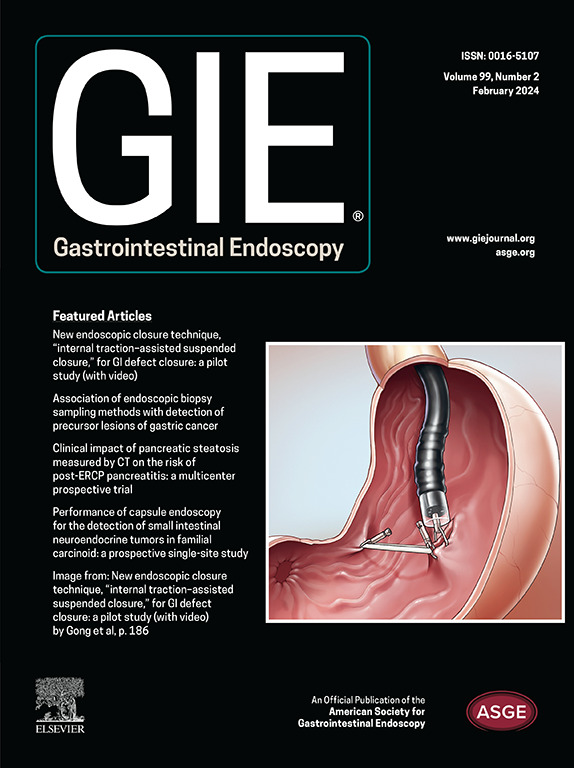Establishment and validation of a risk score model based on EUS: assessment of lymph node metastasis in early gastric cancer
IF 7.5
1区 医学
Q1 GASTROENTEROLOGY & HEPATOLOGY
引用次数: 0
Abstract
Background and Aims
Lymph node metastasis significantly affects the prognosis of early gastric cancer patients. EUS plays a crucial role in the preoperative assessment of early gastric cancer. This study evaluated the efficacy of EUS in identifying lymph node metastasis in early gastric cancer patients and developed a risk score model to aid in choosing the best treatment options.
Methods
We retrospectively analyzed the effectiveness of EUS for detecting lymph node metastasis in early gastric cancer patients. A risk score model for predicting lymph node metastasis preoperatively was created using independent risk factors identified through binary logistic regression analysis and subsequently validated. Receiver operating characteristic curves were generated for both the development and validation cohorts.
Results
The overall accuracy of EUS in identifying lymph node metastasis was 85.3%, although its sensitivity (29.2%) and positive predictive value (38.7%) were relatively low. Patients were categorized based on preoperative risk factors for lymph node metastasis, including tumor size of ≥20 mm, lymph nodes of ≥10 mm, body mass index of ≥24 kg/m2, and lymph node metastasis on CT scans. A 7-point risk score model was developed to assess the likelihood of lymph node metastasis. The areas under the receiver operating characteristic curve for the development and validation sets were 0.842 and 0.837, respectively, with sensitivities of 64% and 79%, respectively.
Conclusions
We developed a practical risk score model based on preoperative factors to help EUS predict lymph node metastasis in early gastric cancer patients, guiding the selection of optimal treatment approaches for these patients.
基于胃超声波的风险评分模型的建立与验证:早期胃癌淋巴结转移评估
背景和目的:淋巴结转移严重影响早期胃癌患者的预后。内镜超声检查(EUS)在早期胃癌的术前评估中起着至关重要的作用。本研究评估了 EUS 识别早期胃癌患者淋巴结转移的效果,并建立了一个风险评分模型,以帮助选择最佳治疗方案:我们对 EUS 检测早期胃癌患者淋巴结转移的有效性进行了回顾性分析。利用二元逻辑回归分析确定的独立风险因素,建立了预测术前淋巴结转移的风险评分模型,并随后进行了验证。结果显示,EUS识别淋巴结转移的总体准确率为99.9%:尽管 EUS 的敏感性(29.2%)和阳性预测值(38.7%)相对较低,但 EUS 识别淋巴结转移的总体准确率为 85.3%。根据术前淋巴结转移的风险因素对患者进行分类,包括肿瘤大小≥20 mm、淋巴结≥10 mm、体重指数≥24 kg/m2、CT扫描发现淋巴结转移。建立了一个 7 点风险评分模型来评估淋巴结转移的可能性。开发集和验证集的 ROC 曲线下面积(AUC)分别为 0.842 和 0.837,灵敏度分别为 64% 和 79%:我们根据术前因素建立了一个实用的风险评分模型,帮助 EUS 预测早期胃癌患者的淋巴结转移情况,从而指导这些患者选择最佳治疗方法。
本文章由计算机程序翻译,如有差异,请以英文原文为准。
求助全文
约1分钟内获得全文
求助全文
来源期刊

Gastrointestinal endoscopy
医学-胃肠肝病学
CiteScore
10.30
自引率
7.80%
发文量
1441
审稿时长
38 days
期刊介绍:
Gastrointestinal Endoscopy is a journal publishing original, peer-reviewed articles on endoscopic procedures for studying, diagnosing, and treating digestive diseases. It covers outcomes research, prospective studies, and controlled trials of new endoscopic instruments and treatment methods. The online features include full-text articles, video and audio clips, and MEDLINE links. The journal serves as an international forum for the latest developments in the specialty, offering challenging reports from authorities worldwide. It also publishes abstracts of significant articles from other clinical publications, accompanied by expert commentaries.
 求助内容:
求助内容: 应助结果提醒方式:
应助结果提醒方式:


